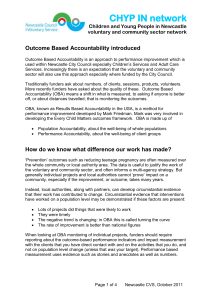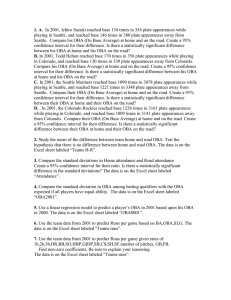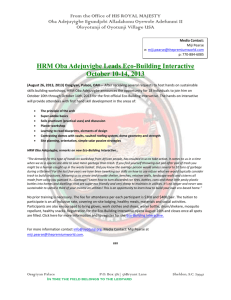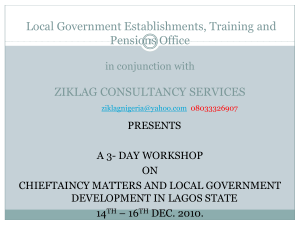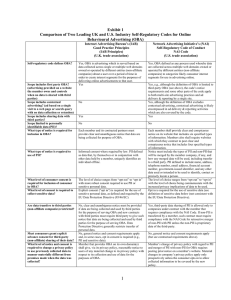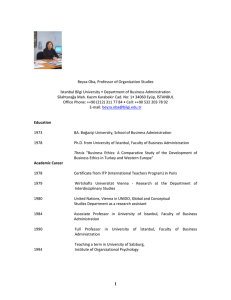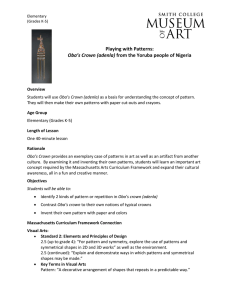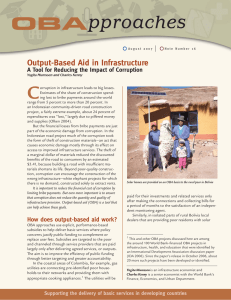Measuring the impact of service delivery through outcomes
advertisement
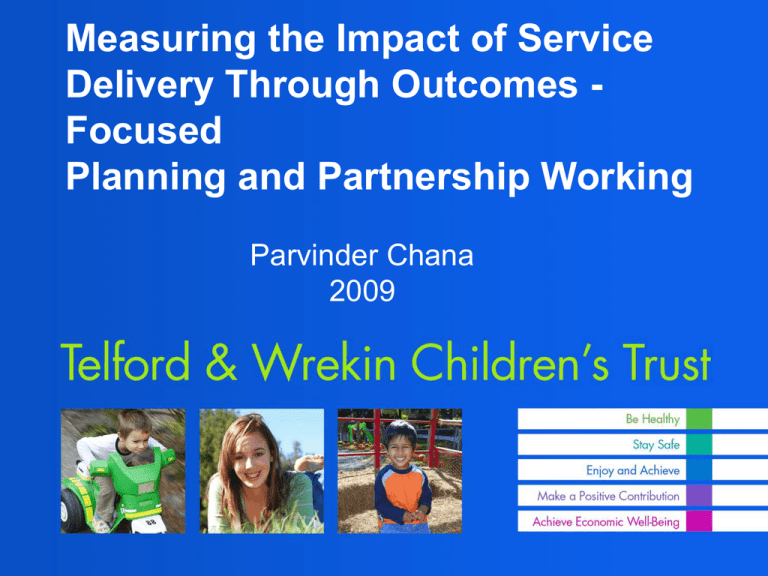
Measuring the Impact of Service Delivery Through Outcomes Focused Planning and Partnership Working Parvinder Chana 2009 What is the purpose and direction of OBA? – – – – – starts with the ends works backwards, common language work effectively with partners budgetary requirements are defined and appropriate – low/non cost initiatives implemented almost immediately – talk to action quickly – best outcomes Benefits of OBA – – – – – Integrate local data link to outcomes to support service planning Identify data gaps prioritise outcomes and performance indicators joint ownership for the agreement of desired outcomes – actions necessary to achieve them, – either within a community or within a service area Outcome Based Accountability is made up of two parts: Population Accountability about the well-being of WHOLE POPULATIONS For Communities – Cities – Counties – States – Nations Performance Accountability about the well-being of CUSTOMER POPULATIONS For Programmes – Agencies – and Service Systems OBA Example Outcome • Lose weight and be more confident Indicators • Number of lbs lost • Decrease in dress size • Increase in confidence Story behind the baseline (causes) • No time to exercise • Eating out most of the time because there’s no shopping in the house • Eating in a rush and not thinking about how healthy the food I’m eating is • Sitting at a desk all day at work OBA Example Continued Partners • • • • • Partner Dog Gym instructor Work colleague Friends What works? • Weightwatchers • Calorie controlled diet • Physical activity OBA Example Continued Action Plan • • • • • • • Join local gym Initial gym lesson with gym instructor to produce a workout plan for me to follow Go gym every Monday (and one other day during the week) Go shopping with my partner every Sunday Join Weight watchers and plan a healthy shopping list for the Sunday shopping Reward with an outfit at the end of each month • • • • • • Take a packed lunch from home to eat at work Walk up the stairs at work and not use lift Use the toilets on the 1st floor and use stairs to toilets and office each time Take dog out for 30 minute walk every other day Go for a walk at lunch time with work colleague Join Salsa class with friends Population Accountability Using OBA Working through 6 Exercises 1. Common ground (will help to look at identifying partners for the action planning stage) 2. Choosing priorities 3. Outcomes & Indicators 4. Story behind the baseline (Analysis of plotted chart) 5. What Works? (locally, regionally, nationally) 6. Action planning/partners Performance Accountability Three Simple Performance Measure Categories • How much did we do? • How well did we do it? • Is anyone better off? All performance measures… …that have ever existed for any service can be derived from thinking about the quantity and quality of effort and effect Quantity and Quality Distinction between quantity and quality is familiar: How much we did Vs How well we did it Some people think that quantity can be measured but quality cannot be measured – but it can based on 12 words 1. Did we treat you well? 2. Did we help you with your problems? Effort and Effect The distinction between Effort and Effect is simply the difference between how hard we tried and whether we made a difference in the lives of our customers Quantity Quality How Much How Well Did we do? Did we do it? Effort How hard did we try? Effect What change did we produce? Different perspectives combined • Quantity of effort: How much service was provided? • Quality of effort: How well was the service provided? • Quantity of effect: How many customers are better off? • Quality of effect: What % of customers are better off and how are they better off? How much did we do? Least important How well did we do it? 2nd Most important # is anyone better off 3rd Most important % is anyone better off Most important How much do we do? # Customers served How Well did we do it? % Common measures (by customer characteristic) Workload ratio, Staff Turnover rate, Staff morale ,Percent of staff fully trained, Worker Safety, Unit cost , Customer satisfaction (did we treat you well?) # Activities (By type of activity) % Activity-specific measures Percent of actions timely and correct, percent clients completing activity, percent of actions meeting standards Is anyone better off? Is anyone better off? # Skills/Knowledge # Attitude/Opinion # Behaviour # Circumstance % Skills/Knowledge % Attitude/Opinion (including customer satisfaction) % Behaviour % Circumstance Group Exercise 1. Pick a service in your group 2. Think about the common measures for the service and plot them into the quadrant 3. Discuss and identify any gaps in measures and plot them into the quadrant 4. Pick measures from the right hand upper and lower quadrants and identify barriers 5. Refer back to your barriers and discuss actions that could help over come these barriers How does this link to Population Accountability A population workshop organised where partners come together will help to identify areas that potentially could be included/improved in your service development - Use this as a basis for your background to plan your performance workshop • Think about the measures that were identified in the population workshop • think about what links your service into the population measures • what are the gaps in your measures • At the population review share best practice from your agency that is evidence based as what works for your service Measuring Outcomes • When thinking ‘is anyone better off’ think about how you identify the outcome for individuals and how you will know if they have moved to achieving the outcome. (Distance Travelled) • Build this into your initial assessments reviews and closure so you can see whether the service is moving the individual in the right direction • Link your presenting factors (why intervention was needed) to your Trust priorities and the ECM Framework Partnership Working • You cannot solve population wide issues as a single service • Look outside your own world view and see how you can work with other agencies/services to improve outcomes together
